Looking back at 2013 (3/3): The World's First Solar Window © Jamani Caillet / EPFL
During the last quarter of the year, construction began on an impressive glass façade composed of 300 square meters of dye solar cells for EPFL’s Swiss Tech Convention Center. This is a world first. Breton lighthouses have been reinforced by a combination of materials developed in an EPFL laboratory, and life has become difficult for perfume counterfeiters due to a new detection process. A new work and meeting space for emerging start-ups was established on campus in mid-November. And just before 2013 ended, EPFL obtained control of a new national research center dedicated to the development of innovative materials through the use of computer simulations.
Concrete Developed at EPFL to Rescue Brittany’s Lighthouses
Making Industrial Plasma Safer
Sniffing Out Fake Perfumes
A Remote Swiss Valley Models Global Climate
The Matterhorn Like You’ve Never Seen It
A Natural Boost for MRI Scans
Tracking Micropollutants in Lake Geneva
Geneticists Map Human Resistance to AIDS
Gimball: a Crash-happy Flying Robot
EPFL’s Campus Has the World’s First Solar Window
The Campus Opens Its Hub for Aspiring Entrepreneurs
Ten Times More Throughput on Optic Fibers
EPFL Has Become the Swiss Capital of Research on New Materials

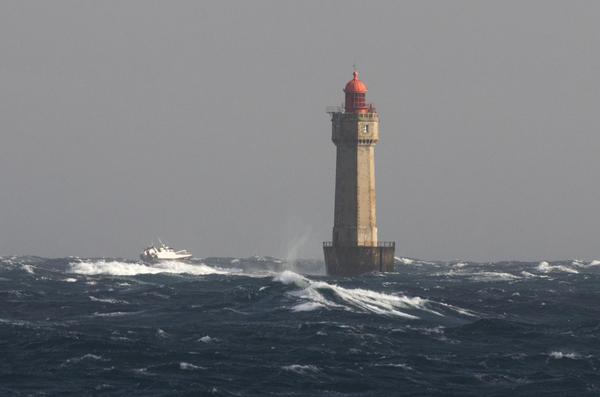 04.09.13 – Despite ongoing constructive reinforcements, lighthouses inevitably deteriorate from the sea’s incessant attacks. A lighthouse turret off the coast of Lorient in Brittany has been enhanced with technology developed for bridges by the Laboratory of Maintenance, Building and Construction Safety (MCS) at EPFL. This trial run will test the application of Ultra-High Performance Concrete (UHPC), a mixture of cementing materials – identical to what is found in most modern concrete – and steel fibers. The Centre for Maritime and Fluvial Studies (CETMEF) in Brest, which oversees the management of such marine construction, has accepted the proposal of EPFL engineers, in partnership with Lafarge, to develop the application of high-performance concrete cast in situ to stop the destruction of these honorable sentries.
04.09.13 – Despite ongoing constructive reinforcements, lighthouses inevitably deteriorate from the sea’s incessant attacks. A lighthouse turret off the coast of Lorient in Brittany has been enhanced with technology developed for bridges by the Laboratory of Maintenance, Building and Construction Safety (MCS) at EPFL. This trial run will test the application of Ultra-High Performance Concrete (UHPC), a mixture of cementing materials – identical to what is found in most modern concrete – and steel fibers. The Centre for Maritime and Fluvial Studies (CETMEF) in Brest, which oversees the management of such marine construction, has accepted the proposal of EPFL engineers, in partnership with Lafarge, to develop the application of high-performance concrete cast in situ to stop the destruction of these honorable sentries.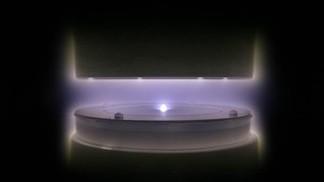 18.09.13 – A team led by Christoph Hollenstein at EPFL’s Center for Plasma Physics Research (CRPP) have uncovered the physics behind the formation of plasmoids – funnel-like, high-energy plasmas that can severely damage industrial plasma reactors, causing millions in repairs and lost productivity in plasma technologies like those used to make display screens and even food containers. Discovering the physics behind plasmoid formation makes it possible for the plasma industry to devise strategies to suppress them. By regulating the plasmoid-forming mechanisms of their reactors, manufacturers can minimize or prevent plasmoids altogether.
18.09.13 – A team led by Christoph Hollenstein at EPFL’s Center for Plasma Physics Research (CRPP) have uncovered the physics behind the formation of plasmoids – funnel-like, high-energy plasmas that can severely damage industrial plasma reactors, causing millions in repairs and lost productivity in plasma technologies like those used to make display screens and even food containers. Discovering the physics behind plasmoid formation makes it possible for the plasma industry to devise strategies to suppress them. By regulating the plasmoid-forming mechanisms of their reactors, manufacturers can minimize or prevent plasmoids altogether.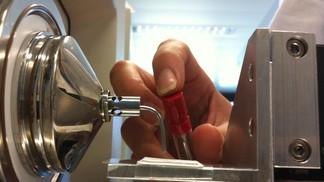 25.09.13 – Counterfeit perfumes are costing both the cosmetics industry and consumers significant amounts of money. But identifying imitation perfumes can be a difficult and time-consuming task, despite a number of available analytical techniques. Hubert Giraud and his team have designed a quick method for detecting counterfeit perfumes, called Electrostatic Spray Ionization, that can analyze and identify counterfeit perfumes faster than conventional methods. It has been tested on major brands such as Givenchy, Hermes and D&G. With no need for time-consuming preparations of the samples before testing, a perfume’s “fingerprint” can be recorded and identified with unprecedented speed and efficiency.
25.09.13 – Counterfeit perfumes are costing both the cosmetics industry and consumers significant amounts of money. But identifying imitation perfumes can be a difficult and time-consuming task, despite a number of available analytical techniques. Hubert Giraud and his team have designed a quick method for detecting counterfeit perfumes, called Electrostatic Spray Ionization, that can analyze and identify counterfeit perfumes faster than conventional methods. It has been tested on major brands such as Givenchy, Hermes and D&G. With no need for time-consuming preparations of the samples before testing, a perfume’s “fingerprint” can be recorded and identified with unprecedented speed and efficiency. 04.10.13 – EPFL scientists have developed a new statistical model of extreme rainfall in the Swiss Val Ferret region, which can be used across the globe. Climate change and the rise in the Earth’s temperatures are expected to have a direct impact on weather conditions. Therefore, new models are needed. The objective of the study led by Anthony Davison and his team was to create a model to understand how extreme rainfall events were distributed over time and space. The team used twenty-four weather stations including data from a MétéoSuisse weather station located at the Great St. Bernard Pass (Col du Grand-St-Bernard), which has collected rainfall data over 31 years (1982-2012).
04.10.13 – EPFL scientists have developed a new statistical model of extreme rainfall in the Swiss Val Ferret region, which can be used across the globe. Climate change and the rise in the Earth’s temperatures are expected to have a direct impact on weather conditions. Therefore, new models are needed. The objective of the study led by Anthony Davison and his team was to create a model to understand how extreme rainfall events were distributed over time and space. The team used twenty-four weather stations including data from a MétéoSuisse weather station located at the Great St. Bernard Pass (Col du Grand-St-Bernard), which has collected rainfall data over 31 years (1982-2012).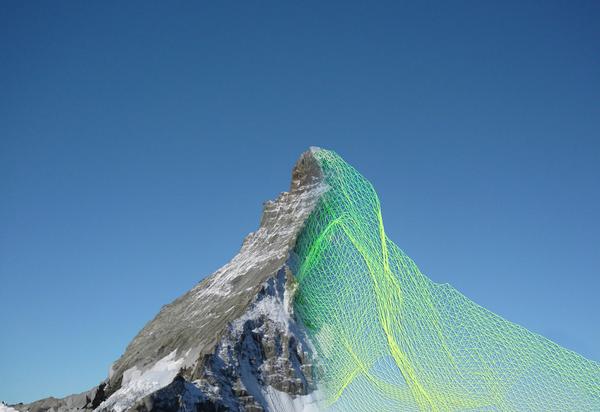 15.10.13 – Two EPFL spin-offs, senseFly and Pix4D (IC), have modeled the Matterhorn in 3D, at a level of detail never before achieved. It took senseFly’s ultralight drones just six hours to snap the high altitude photographs that were needed to build the model. They weigh less than a kilo each, but they’re as agile as eagles in the high mountain air. “We want, above all, to demonstrate what our devices are capable of achieving in the extreme conditions that are found at high altitudes,” explains Jean-Christophe Zufferey, head of senseFly. In addition to the challenges of altitude and atmospheric turbulence, the drones also had to take into consideration, for the first time, the volume of the object being photographed. Up to this point they had only been used to survey relatively flat terrain. The only remaining task was for software developed by Pix4D, another EPFL spin-off, to assemble them into an impressive 300-million-point 3D model.
15.10.13 – Two EPFL spin-offs, senseFly and Pix4D (IC), have modeled the Matterhorn in 3D, at a level of detail never before achieved. It took senseFly’s ultralight drones just six hours to snap the high altitude photographs that were needed to build the model. They weigh less than a kilo each, but they’re as agile as eagles in the high mountain air. “We want, above all, to demonstrate what our devices are capable of achieving in the extreme conditions that are found at high altitudes,” explains Jean-Christophe Zufferey, head of senseFly. In addition to the challenges of altitude and atmospheric turbulence, the drones also had to take into consideration, for the first time, the volume of the object being photographed. Up to this point they had only been used to survey relatively flat terrain. The only remaining task was for software developed by Pix4D, another EPFL spin-off, to assemble them into an impressive 300-million-point 3D model. 22.10.13 – Using an innocuous agent that is naturally produced in the body, EPFL researchers have developed a breakthrough method that can make contrast-enhanced MRI safer and cheaper. One weakness of MRI scans is a low sensitivity that, until today, could only be improved by injecting a patient with a potentially toxic dye contrast. A research team led by Arnaud Comment found that high resolution in a contrast-enhanced MRI can be achieved with pyruvic acid, an organic chemical that occurs naturally in the body as a result of glucose breakdown – without the need of persistent radicals. The resulting images showed detailed spatial and temporal resolution to the point of tracking the metabolism of pyruvic acid in the animal’s brain. This study, which arose from a collaboration of EPFL with Paul Scherrer Institut, UNIL, and the University of Geneva, was published in PNAS. The authors believe that the technique will be rapidly incorporated into the clinical setting and call it “a substantial step forward toward clinical radiology free of side effects.”
22.10.13 – Using an innocuous agent that is naturally produced in the body, EPFL researchers have developed a breakthrough method that can make contrast-enhanced MRI safer and cheaper. One weakness of MRI scans is a low sensitivity that, until today, could only be improved by injecting a patient with a potentially toxic dye contrast. A research team led by Arnaud Comment found that high resolution in a contrast-enhanced MRI can be achieved with pyruvic acid, an organic chemical that occurs naturally in the body as a result of glucose breakdown – without the need of persistent radicals. The resulting images showed detailed spatial and temporal resolution to the point of tracking the metabolism of pyruvic acid in the animal’s brain. This study, which arose from a collaboration of EPFL with Paul Scherrer Institut, UNIL, and the University of Geneva, was published in PNAS. The authors believe that the technique will be rapidly incorporated into the clinical setting and call it “a substantial step forward toward clinical radiology free of side effects.”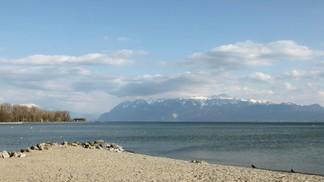 25.10.13 – Antibiotics, urban pesticides, and other contaminants accumulate where wastewater is released into Lake Geneva. Using computer simulations, EPFL researchers have shown that the risk they pose is highest during summer and that they degrade most efficiently during the winter. Florence Bonvin, of EPFL’s Environmental Chemistry Lab, has been studying the persistent underwater pollution emitted by Lausanne’s water treatment plant as well as expelled substances in the plume. The computer model developed by the researcher facilitates the quantification of the ecotoxoligical threat of 24 micropollutants when released into the lake. It follows their dispersion in the surrounding waters and, ultimately, their decomposition.
25.10.13 – Antibiotics, urban pesticides, and other contaminants accumulate where wastewater is released into Lake Geneva. Using computer simulations, EPFL researchers have shown that the risk they pose is highest during summer and that they degrade most efficiently during the winter. Florence Bonvin, of EPFL’s Environmental Chemistry Lab, has been studying the persistent underwater pollution emitted by Lausanne’s water treatment plant as well as expelled substances in the plume. The computer model developed by the researcher facilitates the quantification of the ecotoxoligical threat of 24 micropollutants when released into the lake. It follows their dispersion in the surrounding waters and, ultimately, their decomposition.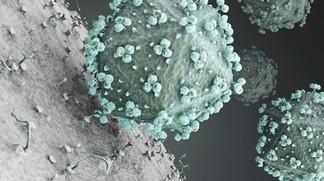 30.10.13 – Do our genes hold the key to future AIDS therapies? Using a supercomputer, scientists analyzed the genomes of thousands of strains of the HIV virus and have produced the first map of human AIDS resistance. They managed to trace the entire chain of events in these battles, from the genome of the virus to the genome of the victim. The goal of their research, published in the journal eLife on the 29th of October, is to find new therapeutic targets and to enable individualized treatment strategies.
30.10.13 – Do our genes hold the key to future AIDS therapies? Using a supercomputer, scientists analyzed the genomes of thousands of strains of the HIV virus and have produced the first map of human AIDS resistance. They managed to trace the entire chain of events in these battles, from the genome of the virus to the genome of the victim. The goal of their research, published in the journal eLife on the 29th of October, is to find new therapeutic targets and to enable individualized treatment strategies.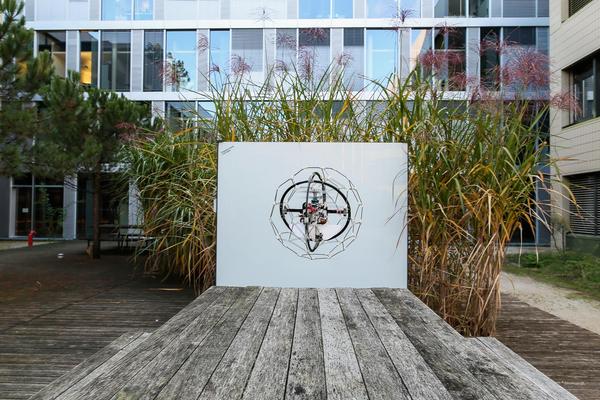 01.11.13 – Gimball bumps into and ricochets off obstacles, rather than avoiding them. This spherical flying robot of 34 centimeter in diameter buzzes around the most unpredictable, chaotic environments, without the need for fragile detection sensors. Powered by twin propellers and steered by fins, Gimball can stay on course despite numerous collisions. Adrien Briod and Przemyslaw Mariusz Kornatowski developed the gyroscopic stabilization system consisting of a double carbon-fiber ring that keeps the robot oriented vertically, while the cage absorbs shocks as it rotates. Gimball’s robustness lies in its technological simplicity, says Briod. “Flying insects handle collisions quite well. For them, shocks aren’t really accidents, because they’re designed to bounce back from them. This is the direction we decided to take in our research.”
01.11.13 – Gimball bumps into and ricochets off obstacles, rather than avoiding them. This spherical flying robot of 34 centimeter in diameter buzzes around the most unpredictable, chaotic environments, without the need for fragile detection sensors. Powered by twin propellers and steered by fins, Gimball can stay on course despite numerous collisions. Adrien Briod and Przemyslaw Mariusz Kornatowski developed the gyroscopic stabilization system consisting of a double carbon-fiber ring that keeps the robot oriented vertically, while the cage absorbs shocks as it rotates. Gimball’s robustness lies in its technological simplicity, says Briod. “Flying insects handle collisions quite well. For them, shocks aren’t really accidents, because they’re designed to bounce back from them. This is the direction we decided to take in our research.”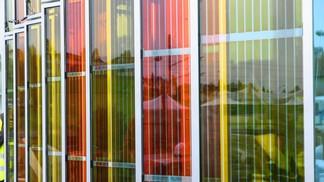 05.11.13 – A façade of 300 square meters made of Grätzel solar dye cells is under construction on the west side of the Swiss Tech Convention Center. This architectural integration on an external wall is a world first. The architectural integration of this technology is a new step in the collaboration between Romande Energy and EPFL to develop a large-scale solar park and conduct research and development projects. These 1,400 solar modules, each one 35 by 50 cm in size, are available in 5 different shades of red, green and orange, as designed by artists Daniel Schlaepfer and Catherine Bolle, which gives the entirety a warm, dynamic aesthetic.
05.11.13 – A façade of 300 square meters made of Grätzel solar dye cells is under construction on the west side of the Swiss Tech Convention Center. This architectural integration on an external wall is a world first. The architectural integration of this technology is a new step in the collaboration between Romande Energy and EPFL to develop a large-scale solar park and conduct research and development projects. These 1,400 solar modules, each one 35 by 50 cm in size, are available in 5 different shades of red, green and orange, as designed by artists Daniel Schlaepfer and Catherine Bolle, which gives the entirety a warm, dynamic aesthetic. 20.11.13 – The Forge, inaugurated November 19 in EPFL’s Innovation Park, provides aspiring entrepreneurs an office space to develop their start-ups as well as a location for networking and advice. The Forge offers an open space with a conference room, several meeting booths, free Internet access, and a printer. The place is flexible: there are no reserved offices. Even though it only just opened, it already hosts 16 future companies in fields as diverse as computer science, life sciences, and communications.
20.11.13 – The Forge, inaugurated November 19 in EPFL’s Innovation Park, provides aspiring entrepreneurs an office space to develop their start-ups as well as a location for networking and advice. The Forge offers an open space with a conference room, several meeting booths, free Internet access, and a printer. The place is flexible: there are no reserved offices. Even though it only just opened, it already hosts 16 future companies in fields as diverse as computer science, life sciences, and communications.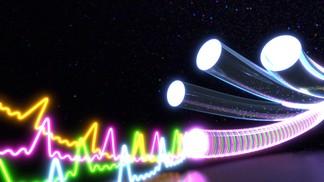 05.12.13 – Optical fibers carry data in the form of pulses of light over distances of thousands of miles at amazing speeds. They are one of the glories of modern telecommunications technology. However, their capacity is limited, because the pulses of light need to be lined up one after the other in the fiber with a minimum distance between them. A simple, innovative solution, developed by Camille Brès and Luc Thévenaz of the Photonics Systems Laboratory (PHOSL), reduces the amount of space required between the pulses of light that transport data. The breakthrough could increase the throughput of data in telecommunications systems by a factor of ten. The new pulses should be of great interest to many telecommunications-industry market participants. The technology is already mature, as well as 100% optic and relatively cheap. In addition, it appears that it could fit on a simple chip. “It almost seems too good to be true,” laughs Luc Thévenaz.
05.12.13 – Optical fibers carry data in the form of pulses of light over distances of thousands of miles at amazing speeds. They are one of the glories of modern telecommunications technology. However, their capacity is limited, because the pulses of light need to be lined up one after the other in the fiber with a minimum distance between them. A simple, innovative solution, developed by Camille Brès and Luc Thévenaz of the Photonics Systems Laboratory (PHOSL), reduces the amount of space required between the pulses of light that transport data. The breakthrough could increase the throughput of data in telecommunications systems by a factor of ten. The new pulses should be of great interest to many telecommunications-industry market participants. The technology is already mature, as well as 100% optic and relatively cheap. In addition, it appears that it could fit on a simple chip. “It almost seems too good to be true,” laughs Luc Thévenaz. 17.12.13 - The Federal Councilor Johann Schneider-Amman has unveiled eight new National Centers of Competence in Research (NCCR), which will receive substantial funding from the Swiss National Science Foundation. The “MARVEL” project, managed by EPFL and dedicated to developing innovative materials using powerful computer simulations, was one of the winning submissions. Led by Professor Nicola Marzari, the new NCCR aims to trigger a revolution in the field of the conception and discovery of new materials.
17.12.13 - The Federal Councilor Johann Schneider-Amman has unveiled eight new National Centers of Competence in Research (NCCR), which will receive substantial funding from the Swiss National Science Foundation. The “MARVEL” project, managed by EPFL and dedicated to developing innovative materials using powerful computer simulations, was one of the winning submissions. Led by Professor Nicola Marzari, the new NCCR aims to trigger a revolution in the field of the conception and discovery of new materials.